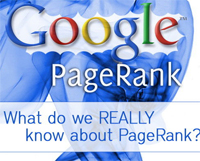What you do not know about pagerank?
Pagerank is merely a way for Google to assess the reliability and quality of each website in its portfolio, based on how often they visit on the Internet. Another approach a technical than pagerank definition (abbreviated as PR) is a link analysis algorithm ket.Nhung this mechanism there are two variants of this mechanism, recently it was discovered the nature of 2 PageRank face; one hand it is the system used by Google specific extraction and analysis, also known as PR performance (Real PR); on the other hand, there are types of PR displayed in the status bar specific values from 0 -10, also known as the Toolbar PR that webmasters are now exploited to test Google’s appreciation for a certain website.
Although the two variants of PR activities on the basis of arithmetic, then PR is represented by the number of indicators even millions in the Toolbar PR only to scale 10 is high nhat.Theo mechanism of normal toolbar PR, all of the sites listed are classified into 11 different class, based on their fixed values.
For example, using the second page, one with PR 2 and PR 4, the difference between them is not merely second in the words of the PR, but also much larger.
Unfortunately, little is known how the Google PR value of a website where new is limited to determining the breaking point – ranking decision point 11.
Each rank Toolbar PageRank increases exponentially compared to the previous PR, how to increase the rating is not easy. In other words, what should be enough to get one website from PR2 to PR 3 is far from enough to move from PR3 to PR4.
Here are some steps to help you understand the mechanics of an easier way:
1. Google assesses the webpage is not available.
2. PR versus PR toolbar can display more than a little less, or pretty much difference.
3. In the ranking process, all the backlink derived from a low-ranking domainweb will bring about PR1 only.
4. Each webpage is to define a small initial value of PR is often known as (1-d), where d is a variable defined by Google under the name “damping factor – destructive elements”, and each page is given an initial value of 0.85. It added to the initial PR of per page 0.15 units worth.
5. To facilitate a webpage towards a higher position in the toolbar, you have to constantly increase the number of links to your website.
6. PR on the toolbar to change 3 months 1 times. Meanwhile PR constantly updated, this explains why the list of search results a certain web page to be displayed in a higher position better page rank. This is another difference in the two sides of the PR nature.
7. PR also be programmed to analyze the structural design of a webpage link.
How Google works: After you collected a relatively webpage in the number of their portfolio, Google will rank the page according to the reliability and reputation of the page – indicated by the number of links leading to web it. Of course the internal elements of the page are also taken into account to evaluate rankings.
– A website to get more PR when the inbound links from other sites
– The link comes from other pages within one website, or from entirely different domain also received similar rankings for the PR value of the page.
– Outbound links you have lost the PR value of the webpage. That fact, as mentioned in a previous post, Google also encouraged by increasing the rankings when there are many links to sites with content suitable and reliable.
– To fully understand the PR method, you need to know when a PR-assigned to a different webpage – is divided by the total number of links on the home page.
– Finally, thanks to eliminate factors that a link to identify only 85% of its value only.

